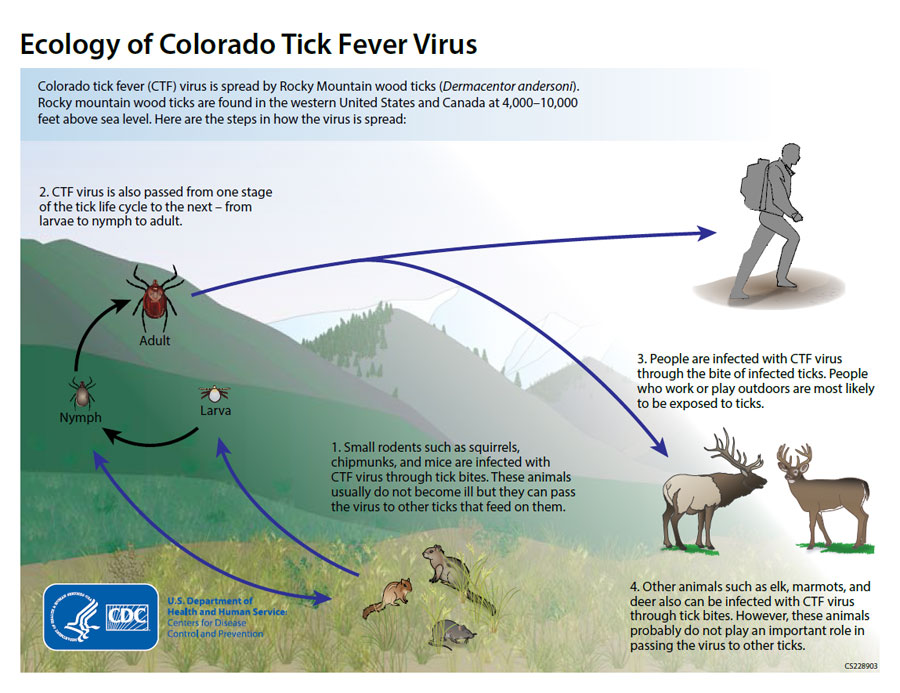Colorado tick fever causes
Editor-In-Chief: C. Michael Gibson, M.S., M.D. [1] Associate Editor(s)-in-Chief: Ilan Dock, B.S.
Overview
Colorado Tick Fever (CTF) (also called Mountain tick fever, Mountain fever, and American mountain fever) is an acute viral infection transmitted from the bite of an infected wood tick (Dermacentor andersoni). It should not be confused with the bacterial tick-borne infection, Rocky Mountain Spotted Fever. The type species of the genus Coltivirus, Colorado tick fever virus (CTFV) infects haemopoietic cells, particularly erythrocytes, which explains how the virus is trasmitted by bloodsucking ticks and also accounts for the incidence of transmission via blood transfusion. The disease develops from March to September, with the highest infections occurring in May and June. [2] The disease is found almost exclusively in the western United States and Canada, mostly in high mountain areas such as Colorado and Idaho. The CTFV was first isolated from human blood in 1944. [3]
The virus particle, like other Coltiviruses, is ~80 nm in diameter and is generally non-envolped. The double stranded RNA viral genome is ~20,000bp long and is divided into 12 segments, which are termed Seg-1 to Seg-12. Viral replication in infected cells is associated with characteristic cytoplasmic granular matrices. Evidence suggests that viral presence in mature erythrocytes is a result of replication of the virus in hematopoitic erythrocyte precursor cells and simultaneous maturation of the infected immature cells rather than off direct entry and replication of CTFV in mature erythrocytes.[4]
The wood tick is usually found attached to a host, but when it is without a host it hides in cracks and crevices as well as soil. If for some reason the tick is not able to find a host before the winter months, it will stay under groundcover until spring when it can resume its search. The wood tick typically does not seek out available hosts in the hottest summer months as well. Adult ticks, for the most part, tend to climb to the top of grass and low shrubs to attach themselves to a host that is wandering by. These ticks are able to attach to their hosts by secreting a cement-like substance from their mouths and inserting it into the host.[5]
Historical Perspective
Colorado tick fever remains a rare disease without a well established historical perspective.
Pathogen life cycle
- The life cycle of Rickettsia rickettsii is considered to be a complex one.
- Survival is dependent on both an invertebrate vector, (the hard tick- Family Ixodidae) and a vertebrate host (including mice, dogs, rabbits).
- Humans are considered to be accidental vectors and are not essential in the rickettsial cycle.
- In addition, a sequence of events occur between both hosts in the successful transmission of rickettsial disease.
- (Rickettsia rickettsii mostly affects canines and humans.) [1]
Viral classification
- Genera of Colorado tick fever is wither an Orbivirus or Coltivirus.
- Four serotypes are responsible for human infections.[2]
Pathogenisis
- Viral pathway involves targeting the cells in bone marrow or young child's central nervous system.
- Inhibits the proper development of blood cells.
- A host defense mechanism, humoral immunity, is elicited by infection.[2]
Epidemiology and Demographics
Incidence
- Colorado tick fever is not a nationally notifiable disease.
- 83 cases of Colorado tick fever have been reported between the years of 2002 and 2012.[3]
Geography of Rocky Mountain spotted fever
Specifically reported in the following six states:
- Arizona
- Colorado
- Montana
- Oregon
- Utah
- Wyoming[3]
Transmission
- Infection with Colorado tick fever occurs as a result of being bitten by an infected Rocky Mountain wood tick (Dermacentor andersoni).
- Colorado tick fever is transmitted to a tick during a blood meal involving a rodent reservoir such as a squirrels, chipmunks, and mice.
- Infection perpetuates as a tick continues to feed on another host.
- Viral transmission from human to human is rare, however may occur during blood transfusion.

Epidemiology
- The name Rocky Mountain spotted fever is somewhat of a misnomer. Cases of Rocky Mountain spotted fever have been reported in every continent except Antarctica, and in every state in the U.S. except for Alaska, and Hawaii.
- Approximately 90% of all infections occur within the months of April to September, the time period in which adult and nymphal ticks are the highest. The areas of the U.S. with the greatest reported cases of RMSF are the mid to south Atlantic states, including DE, MD, DC, VA, WV, NC, SC.
- It is estimated that approximately 1200 or more new cases of RMSF will present on a yearly basis. [5]
References
- ↑ Walker, David H. Medical Microbiology 4th Edition. Chapter 38. Rickettsiae. (1996). http://www.ncbi.nlm.nih.gov/books/NBK7624/#A2139 Accessed on January 7, 2016
- ↑ 2.0 2.1 Rotaviruses, Reoviruses, Coltiviruses, and Orbiviruses. http://www.ncbi.nlm.nih.gov/books/NBK8558/ 1996; Accessed January 21, 2016.
- ↑ 3.0 3.1 Centers for Disease Control and Prevention Colorado tick fever, Statistics. http://www.cdc.gov/coloradotickfever/statistics.html Accessed January 19, 2016
- ↑ Centers for Disease and Control, Colorado tick fever transmission. http://www.cdc.gov/coloradotickfever/transmission.html Accessed January 20,2016
- ↑ Rocky Mountain Spotted Fever Statistics. Centers for Disease Control and Prevention (2015). http://www.cdc.gov/rmsf/stats/ Accessed on December 30, 2015